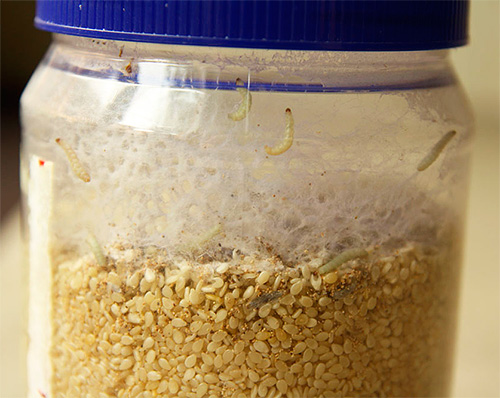
The name “food moth” is popularly understood as several types of moths - small butterflies, the caterpillars of which feed on cereals, nuts and groceries. Each of these species has its own characteristics, however, despite the fact that externally different types of food moths are well different from each other, no one wants to understand them especially and is simply looking for ways to get rid of these pests as soon as possible.
At the same time easy and versatile instructions like bring food mothNo - due to the specificity of the nutrition of these butterflies, conventional methods such as aerosol insecticides are not suitable (after all, the poison can get into the food). Therefore, the fight against food moths is always quite troublesome and resource-intensive event.
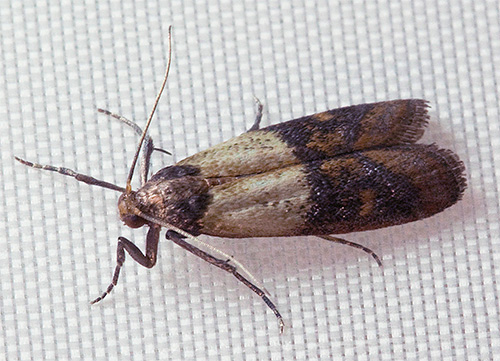
It is interesting
Prior to the development of human civilization, all types of fires were rather inconspicuous participants in natural biocenoses, and their caterpillars ate seeds of grasses and trees.But with the advent of granaries, barns and warehouses, and especially with the beginning of the active transportation of goods between countries and continents, the food moth quickly spread throughout the world and became a real cosmopolitan, equally effectively infecting grain in Argentina, China and Chad. And today even industrial ways of dealing with the food moth do not always cope with its destructive activity.
Types of food moths and features of their morphology
If you look at the photos of different types of food moth, you can be surprised how they are generally confused and combined under one name. For example, in the photo below there is a flour moth, one of the most common types of food moth in an apartment:
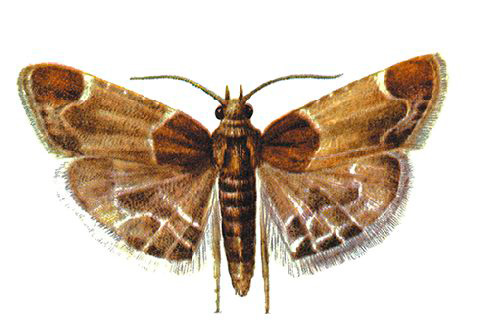
And then the photo shows the mill mill, less catchy and more rare in residential buildings:
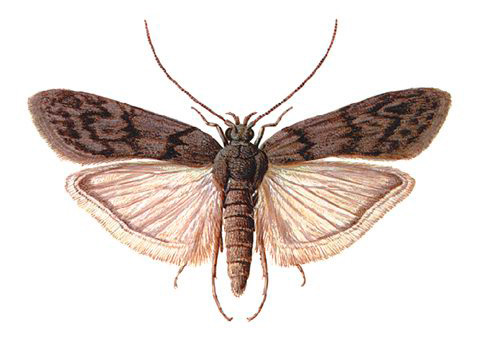
But the southern barn flare, which has a beautiful pattern on the wings. It is often the hardest to get it out:
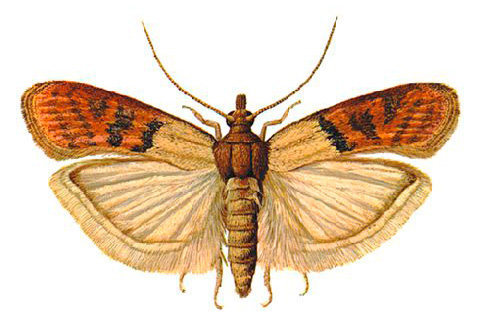
And in the photo below you can see what a cocoa flame looks like - the usual food moth, which can be easily confused with the dressing one because of the inconspicuous light yellow color of the wings:
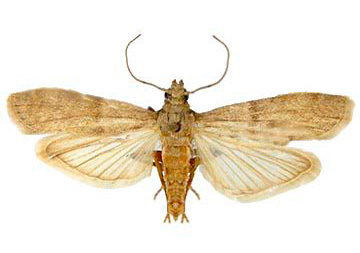
But in general, any food moth looks inconspicuous, even despite the pattern on the wings of some of its species.All of them - butterflies of inconspicuous colors and small sizes.
Typically, the length of the wings does not exceed 7-8 mm, and sitting on the surface, the insect folds them and becomes like a small protrusion on the surface. Not surprisingly, the simple look of a resident of a city apartment is usually not able to catch the difference in the coloring of these butterflies.
On a note
For an unprepared resident of a big city, the food and clothing moths are very similar. The easiest way to distinguish them by meeting places is that the clothes moth rarely catches the eye in the kitchen, and the food one, on the contrary, does not favor the attention of wardrobes and bedrooms.
But the larvae of the food moth - all on one "face". These are small (up to one and a half centimeters) white-yellow or white-pink caterpillars without any hair or processes on the body. Usually, it is impossible to determine the belonging of a caterpillar to this or that fire in appearance. Fortunately, it is possible to breed them all in the same ways, and it is not necessary to determine the species of the larvae.
For example, in the photo below - the larva of the food moth of a flour moth:
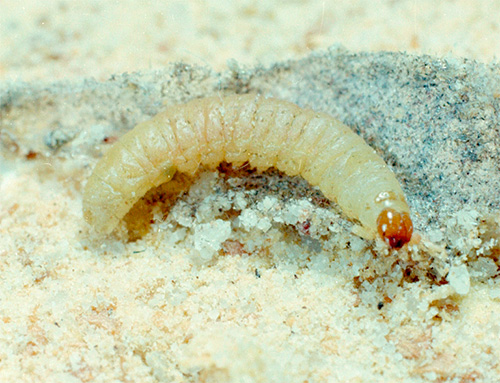
And in the next picture - the larva of cocoa moth. Even despite the obvious differences in the coloring of adult butterflies, their larvae are very similar:
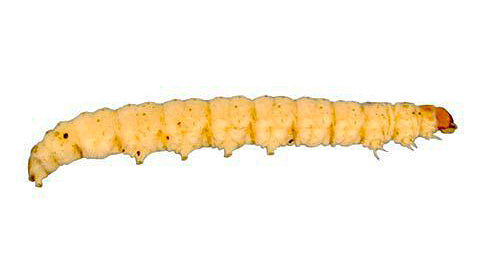
On a note
The larvae of the food moth lead a secretive and sedentary lifestyle.Usually they are caught in the eyes or in contaminated products, or when crawling out of bedside cabinets. In this case, they move along the walls and strongly attract attention. In the photo - such an adult and ready to pupate larva of the food moth.
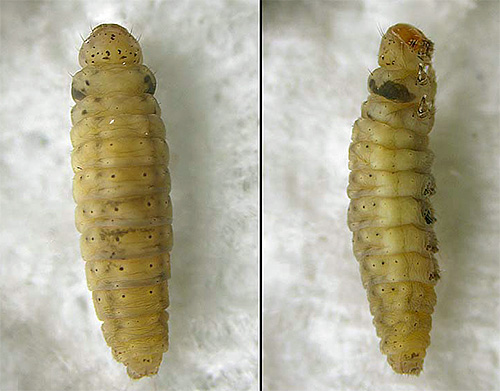
Food moth: some biology
The food moth is a pest with a fairly short reproduction cycle. With a suitable temperature and humidity from eggs to eggs, it takes about two months, and sometimes six weeks.
The optimum conditions for the development of food moth butterflies are about 25 ° C and about 50% humidity. With such air parameters, they develop the fastest, and it is very difficult to remove them.
Adult butterflies of the food moth do not feed at all: their mouths are not developed and the digestive system is not functioning. Yes, and they live a very short time - about a week, mating literally on the first or second day after leaving the pupa. The females remaining a few days devote themselves to laying a hundred or one and a half eggs where the future offspring will find enough food, and the males look for other females or die.

In general, taking into account the larval stage, the food mole lives for about a month and a half. Of these, a week or two goes to metamorphosis in the pupal stage.
Almost always the food moth breeds in the same place where its larvae live. Only in some cases, adult insects mate away from groceries, and the females then return to the feeding environment.
Pest in an apartment: how it gets here, where it lives and what it feeds on
Food moth larvae feed on groceries. Moreover, the food moth eats almost everything indiscriminately: cereals, flour, sugar, cocoa, nuts, dried fruits, bread, crackers, cookies, not very spicy spices, unmilled grain, etc.
The larvae of the food moth are especially numerous in grain warehouses, which can cause considerable damage. Each species has its own food preferences, but in general, the range of food products at each ognevka is wide. In the apartment of any type of food moth eats almost any grocery products.
Thus, wherever there is dry food, a food moth can start.
The photo shows dry apricots, among which are seen the larvae of the food moth. When mass infection of large volumes of such a product to remove the mole is extremely difficult:

Each larva of the food moth not only eats the product in which it lives, but also constantly braids itself with a cocoon of silk. So in the grits or flour appear "incomprehensible" lumps and pellets, and in the nuts - neat nests with a worm inside.
It is important to understand that the food moth is a very bad flyer. It cannot spread between houses, and even more so between food warehouses and apartments, and the food mole in the apartment is taken only with purchases and products from the supermarket. Also, the food moth is turned up in industrial storages: its larvae are transported in grain from one warehouse to another, and their descendants already master abundant food sources.
Harm from food moths
The main harm of the food moth is the deterioration of food. Moth-contaminated groceries can no longer be eaten, and in industrial warehouses infected products are not suitable for sale.
With a serious infection in the warehouse, the food moth is dangerous due to large losses of the product and a strong decrease in its quality.
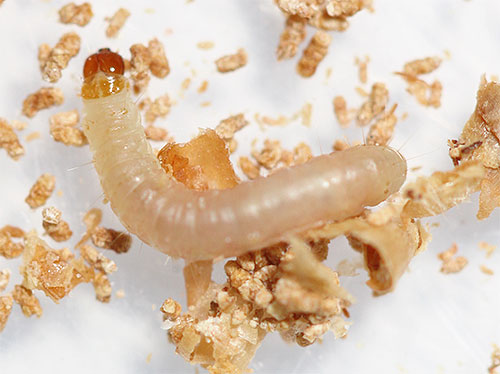
On a note
It is the moth-infected and second-time refined products that enter the market at bargain prices - after all, they need to be sold somehow. And buying them, an ordinary city dweller risks bringing a pest into the home with them.
The food moth does not eat clothes and is not dangerous for the wardrobe.This, however, does not mean that in the presence of food moths in the room you should not worry about things: the clothes and food moths do not interfere with each other and may well cohabit in the same apartment, while mostly individuals of the food moth will come across. In any case, the mole should be removed from the first signs of its detection in the house.
Fight against food moths: measures and means
Fight food moths necessary at all stages of its development. It is wrong to say that if only the larvae harm, then you only need to destroy them: each flying female moth lays in different places up to 160 eggs, from which new caterpillars will emerge within a week.
Therefore, to destroy the food mole must be a complex:
- First you need to find the sources of development of the larvae - to sort through all the food products in which the caterpillars can live, carefully check all the old food stocks. If contaminated products are detected, throw them out or heat them in an oven at a temperature not lower than 60 ° C for half an hour. This is the most reliable way to remove the bulk of pests from home.
- To destroy eggs, larvae and adult butterflies in kitchen cabinets and bedside cabinets, their surfaces must be treated with aerosol insecticides - Armol, Antimol, Raptor from the food moth, Combat.It is not necessary to carefully choose what to poison the food mole - the destruction of the food moth with aerosol preparations implies a kind of “auxiliary” operation, in which only a very small part of insects perish. During this operation, it is important to prevent the ingress of food poisoning.

- Adults flying butterflies in the kitchen can be destroyed with sticky ribbons for flies, fly swatters and a simple newspaper. They fly badly and cannot even slip away from the sneaker. Good for food moth traps, specially designed to attract adults.
A good tool for catching butterflies is the Aeroxon food moth trap. It attracts butterflies with smell, and its glue surface does not dry out for a long time. You can buy such a food moth trap online or in some hardware stores. Its cost is about 200 rubles:
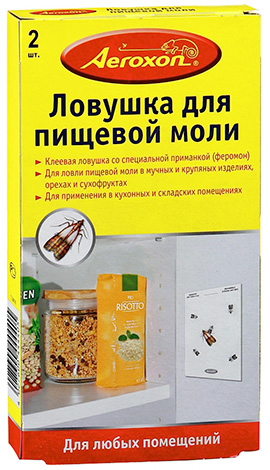
More simple methods of dealing with the food moth have not yet been developed. In industrial plants, moths use phosphine-based fumigators and spraying grain with contact-action insecticides. Conduct a similar food processing indoors.
Measures to protect the home from food moth contamination
Knowing how to kill a food moth is useful, but not enough to protect a room from a pest. It is much wiser not to let him into the house at all, having taken several steps to prevent contamination of the apartment with food moths. Among such measures:
- thorough inspection of all products upon purchase
- avoiding groceries with deliberately low prices
- buying food to be eaten in one week
- the use of mole-repellent agents.
To comply with the last point it is useful to know what is the food moth afraid of. Among the substances that frighten it off are strongly smelling herbs (wormwood, tansy, lavender, rosemary), essential oils, fresh orange peels, household and strawberry soaps, vinegar, horse chestnut cones.
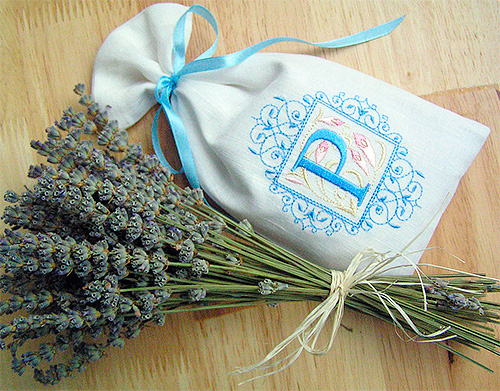
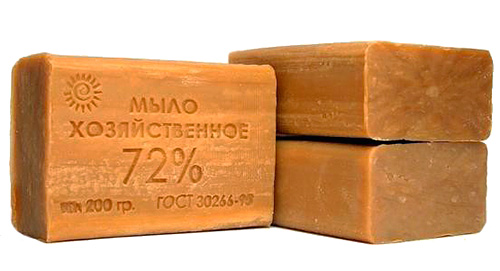
It is only important to remember that if, for example, in a cabinet with neatly laid out lavender to place a jar with a decoy infected moth, the larvae in the croup will not die, and the butterflies that appeared later will no longer be afraid of lavender. That is why the implementation of all preventive measures in the complex is so important.
Useful video: how to properly store food so that the food moth does not start

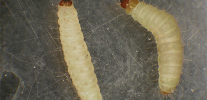
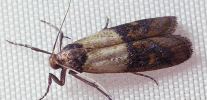
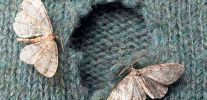
The best way to get rid of the moth is to hang yourself. True, then you will start to eat the worms, but that's another story ...
To prevent worms from eating, the old body is better burned.
She even has a soda! SODA, Karl! This is a tin.